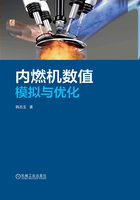
3.1.1 气相控制方程
在本节中,我们将给出笛卡儿坐标系中气相运动的控制方程。这些方程也称为纳维-斯托克斯方程。方程中,x、y、z坐标轴方向上的单位向量分别用下标1、2、3表示。有时为了方便起见,也用x、y和z表示它们。位置矢量x可由以下公式定义为
x=x1i+x2j+x3k
矢量算子定义为

速度矢量u定义为
u=u(x1,x2,x3,t)i+v(x1,x2,x3,t)j+w(x1,x2,x3,t)k
为了易于理解,我们将首先给出可压缩、黏性、导热的理想气体流体的控制方程,随后给出相似但更复杂的刻画多组分、喷雾和化学反应流体的控制方程。这些方程的推导可以在许多书籍中找到[1]。质量守恒方程为

式中,ρ是流体的质量浓度或质量密度;t是时间。
动量守恒方程为

式中,p是流体压力;σij是斯托克斯应力张量;gi是重力加速度。
斯托克斯应力张量的定义为

式中,μ是动力黏度;δ是克罗内克张量,计算公式为

式(3-3)体现了牛顿流体的应力与速度梯度之间的关系。通常将应变率张量定义为

内能守恒方程为

式中,e是内能;qj是由热传导引起的传热量:

式中,T是流体温度;λ是导热系数。
上述方程式可应用于内燃机中的可压缩冷流(例如,进气过程中的可压缩冷流或倒拖发动机中的可压缩冷流)。但是,必须将上述方程式进行推广,才能用来描述涉及多组分、喷雾和化学反应的过程。在这些流体中,组分k的质量守恒方程为

式中,ρk是组分k的质量密度,并且混合气的总质量密度与它的关系式为ρ= 和
和 两个源项分别是由于化学反应和喷雾蒸发/冷凝产生的;D是在菲克扩散定律假设下得到的单一扩散系数,其表达式为
两个源项分别是由于化学反应和喷雾蒸发/冷凝产生的;D是在菲克扩散定律假设下得到的单一扩散系数,其表达式为

式中,Sc是施密特数。
对所有组分应用式(3-7)求和,得到气流整体的质量守恒方程为

整个流体的动量守恒方程为

式中, 是由喷雾引起的源项,其定义式将在下一节中介绍。
是由喷雾引起的源项,其定义式将在下一节中介绍。
整个流体的能量守恒方程为

式中,Jj是传热量,它是热传导和焓扩散贡献的总和:

式中, 和
和 是喷雾和化学反应引起的源项;N是所有组分的数量。
是喷雾和化学反应引起的源项;N是所有组分的数量。
基于将实际气体混合物视为理想气体的假设,给出如下状态方程。考虑到在内燃机中压力和温度的变化范围,这个假设是非常合理的。

式中,R是通用气体常数;Wk是组分k的分子量。